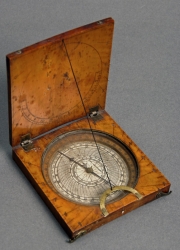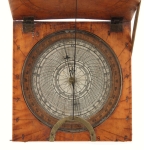Scientific Instrument Society 25th Anniversary Exhibition
Navigation:
<< First | < Previous | Next > | Last >>
45 Boxwood Diptych Dial
Although unsigned, this sundial is attributed to the noted London maker Henry Sutton, who was active in the middle of the 17th century and died during the plague of 1665.
The instrument includes multiple sundials. The upper leaf carries an equinoctial dial on both its faces as well as a polar dial on the upper face and a vertical dial on the inner. The equinoctial and polar dials are both used with a pin gnomon which can be stored for transport in the side of the base; for these two dials, the upper leaf has to be correctly inclined and there is a brass arm for the leaf to be set for any latitude from 0 to 90 degrees.
For the vertical dial to work, the upper leaf must be fixed at exactly 90 degrees to the base and the brass arm can also be set to accomplish this. The shadow for the vertical dial is cast by the string. To keep it taut it can be pulled into either of the slits at the corners of the leading edge of the upper leaf.
The base provides two further dials: a horizontal to complement the vertical, again used with the string and the instrument set at right angles, and a magnetic azimuth dial. The latter is a less common design in which the shadow of the string is used to line up the instrument in the direction of the sun and the time is indicated by the needle’s position on the printed grid of arcs in the compass. The reading needs to be adjusted for the time of year and the innermost circles provide a scale to convert calendar date into solar declination.
The Museum has in its collection two instruments which can be compared with this example. An uncut compass card of 1653 by Sutton with an earlier and more tentative version of the magnetic azimuth dial, and a diptych dial of similar but simpler construction whose compass card is signed “H S”.
S.J.
Collection: Jeff Lock, USA
Objects lent by Jeff Lock, USA:
09. Boxwood Compass, by John Coggs, London, Early 18th Century
10. Ivory German Miner's Compass, by Johann Oberhauser, Schwaz (Tyrol), 1765


